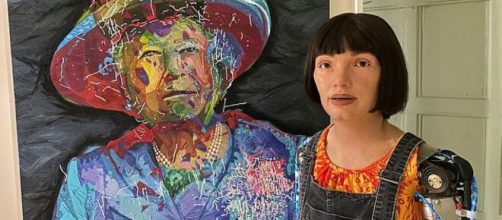Queen Elizabeth’s latest portrait, unveiled last week to celebrate the platinum jubilee, was painted by a robot. The Guardian captioned the story, “But is it art?”
The better question may be, is robot art worthy of discussion? Even when cyborgs are made to look human, you know they’re not sentient, right? Do we really need to have this talk?
As far as I can tell, being sentient is the whole ballgame. Whatever else art by automation is, it can’t dream paintings, and it can’t paint dreams. Android art is push-button art. It doesn’t have awareness.
As flawed as humans are, we have that.
Do I hear a "so what?" Can it be that you think programmed art is a genuine article? It’s not your fault if you do. If you’ve seen one of Warhol’s Brillo boxes, you’ve seen them all. His art has all the spirit of an inanimate object. His studio wasn't called The Factory for nothing.
Truth in fiction
A short story by John Updike makes an unwitting case for the importance of singularity in art. The tale, called “Pigeon Feathers” tells of a farm boy called David. As he turns 14 he fears death and the way people die “like dolls being discarded.” For his birthday, he receives a Remington .22 rifle.
As the story unfolds, David’s grandmother asked him to rid their barn of pigeons roosting in the rafters.
After he guns them down and begins to bury them, he noticed that no two pigeons’ feathers are alike.
That’s when his aha moment hit: “God had lavished such craft upon these worthless birds.” From that, he understood the sanctity of every life, even that of the lowly pigeon.
Art lesson
There’s an art lesson in that tale. Do you see it? Given that a lot of effort went into creating differences among pigeons, uniqueness is a big deal. And with no two fingerprints alike in any of us, it follows that we’re meant to be distinct, one from the other. This would include our artmaking.
You can program a machine to paint a face, but without consciousness, it can’t capture inwardness. The android’s portrait of the Queen shows a blank, television stare under what looks like mosquito netting, which inadvertently furthers the aseptic, lifeless air.
Artificial intelligence just can’t seem to help itself.
It's notable that when the actor Anthony Hopkins created his character of Hannibal Lecter in "Silence of the Lambs," he used the voice of HAL 900, the computer that was the antagonist in the movie "2001: A Space Odyssey."
It was creepy enough when Lecter told Clarice: "A census taker once tried to test me. I ate his liver with some fava beans and a nice chianti." But it got way creepier when he used HAL’s cutting voice to slice clear through you. Hopkins told Variety that he saw Lecter "like a machine." Enough said.


